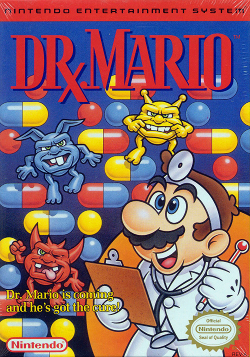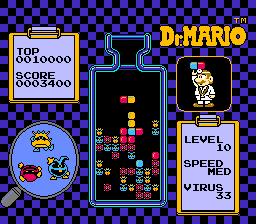Dr. Mario facts for kids
Quick facts for kids Dr. Mario |
|
|---|---|

North American NES box art
|
|
| Developer(s) | Nintendo R&D1 |
| Publisher(s) | Nintendo |
| Producer(s) | Gunpei Yokoi |
| Designer(s) | Takahiro Harada |
| Composer(s) | Hirokazu Tanaka |
| Series | Dr. Mario |
| Platform(s) | NES, Arcade, Game Boy, SNES (Satellaview, Nintendo Power), Game Boy Advance |
| Release date(s) |
July 27, 1990
Game Boy
|
| Genre(s) | Puzzle |
| Mode(s) | Single-player, multiplayer |
| Arcade system | Nintendo VS. System, PlayChoice-10 |
Dr. Mario is a 1990 puzzle video game developed and published by Nintendo for the Nintendo Entertainment System, Famicom, and Game Boy. It was produced by Gunpei Yokoi and designed by Takahiro Harada. The soundtrack was composed by Hirokazu Tanaka.
It is a falling block puzzle game, where the player's objective is to destroy the viruses populating the on-screen playing field by using colored vitamin capsules that are automatically tossed into the field by Dr. Mario. The player manipulates the falling capsules, to align the same colors, which destroys viruses. The player progresses through the game by eliminating all the viruses on the screen in each level.
Dr. Mario was a commercial success, with more than 10 million copies sold worldwide across all platforms. It received generally positive reviews, appearing on several lists of "Best Nintendo Games of All Time". It has been ported, remade, or had a sequel on every Nintendo home console since the NES, and on most portable consoles, including a re-release in 2004 on the Game Boy Advance in the Classic NES Series. It was modified into minigames in WarioWare, Inc.: Mega Microgames!, Brain Age 2: More Training in Minutes a Day!, and Brain Age: Concentration Training. Dr. Luigi is a spin-off for Wii U, released in 2013 as part of the Year of Luigi celebration.
Contents
Gameplay

Dr. Mario is a falling block tile-matching video game. Mario assumes the role of a doctor, tossing two-colored medical capsules into a medicine bottle representing the playing field. This area is populated by viruses of three colors — red, yellow, and blue — which stay in their starting positions until removed. In a style similar to Tetris, the player manipulates each capsule as it vertically falls, able to move it left or right and rotate it 90 degrees clockwise or counter-clockwise. When matching colors of capsule halves and viruses touch sequentially 4-in-a-row, they disappear. Any remaining half or whole capsules which are not supported will fall to the bottom of the playing field or until hitting another supported object, and any new 4-in-a-row alignments also disappear. The main objective is to eliminate all viruses from the playing field, finishing each level. A game over occurs if capsules fill the playing field in a way that obstructs the bottle's narrow neck. After each 5th level is completed on Medium or High difficulty, up to level 20, a cutscene shows the virus trio sitting on a tree as music plays and an object flies across the screen.
The options screen configures the starting level, game speed, and music. The player chooses a starting level between 0 and 20 that determines the number of viruses to clear, and one of three speeds of the falling capsules. The player's score is based on the elimination of viruses and the chosen game speed, with bonus points for clearing more than 1 in a single line.
Dr. Mario offers a multiplayer gaming mode in which two players compete in separate playing fields. Each player's goal is to clear the private playing field of viruses first. Eliminating multiple viruses or initiating chain reactions can add capsules to the opponent's playing field. A player wins a single game upon eliminating all the viruses or upon the other player's bottle filling. The first player to win three games wins overall.
Development

Dr. Mario was produced by Gunpei Yokoi, creator of the Game Boy and Game & Watch handheld systems. Takahiro Harada, producer of the Metroid series, was its designer. Its music was composed by Hirokazu Tanaka, and has been re-used and arranged such as in the Super Smash Bros. series.
Re-releases
Dr. Mario spawned several remakes and ports that were released on various Nintendo consoles. The original version's multiplayer portion was ported to two Nintendo arcade systems in 1990: the Nintendo VS. System (as Vs. Dr. Mario) and the PlayChoice-10.
An enhanced remake of Dr. Mario was paired with Tetris in the Super Nintendo Entertainment System compilation game Tetris & Dr. Mario, released on 30 December 1994. This was re-released in Japan on 30 March 1997, as a downloadable game for the Super Famicom's Satellaview peripheral, with the name Dr. Mario BS Version. It was re-released again in Japan for the Super Famicom's and Game Boy's downloadable Nintendo Power cartridges.
The NES version was ported twice to the Game Boy Advance: first in 2004 as one of thirty games in the Classic NES Series (Famicom Mini Series in Japan), then bundled with a version of the Puzzle League series in 2005 as Dr. Mario & Puzzle League, with updated graphics and new music. Nintendo Puzzle Collection and the Nintendo GameCube Preview Disc, both released in 2003 for the GameCube, can copy the NES version of Dr. Mario to the Game Boy Advance using the Nintendo GameCube – Game Boy Advance link cable. The original Game Boy version was published on the Nintendo 3DS Virtual Console in 2011 and 2012. The NES version was released on the Wii U Virtual Console in 2014 and was one of the launch games for Nintendo Switch Online on September 19, 2018.
See also
 In Spanish: Dr. Mario para niños
In Spanish: Dr. Mario para niños

